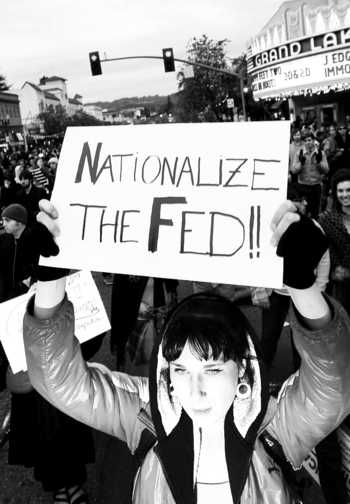
Since the overnight police raid on December 17th, when the camp at Justin Herman Plaza was cleared and around forty people taken into custody, Occupy San Francisco has been preparing for days of mass action.
Tactics are diverse here, and not all actions qualify as ’peaceful protest’. Many announcements clearly state: “If you identify as a peaceful protester, this action might not be for you,” and activists are encouraged to wear black. Occupy Oakland is known locally as, “the only site that fucked the police.”
There are plans to move into a building on January 28th and a “Fuck the Police March” each Saturday, but there are many other ways to participate without risk of arrest, like the Occupy Wall St. West mass occupation on January 20th.
The San Francisco Financial District has long been nicknamed “Wall St. West” and is known as a major centre of corporate power and wealth. Many of the banks and corporations that were key players in the economic melt-down have a presence in San Francisco; Goldman Sachs, Morgan Stanley, Capital International and Merrill Lynch are all here, and now activists have mapped financial institutions for occupying in an effort to disrupt ’business-as-usual’.
“It is important to re-gain the public visibility of our actions”, says Ian B, a young protester who lives in an art community in San Franciso. “With the camp it was easy to stay in the centre of attention, but other visual actions are equally important.”
Leading organisers are Occupy SF GA, Action Council, Occupy SF State University and the Occupy SF Housing Coalition, as well as other supporting organisations such as Jobs with Justice, Code Pink, SF Labor Council and California Nurses Association.
The action is strongly supported by the local Occupy Justice group that tracks people in jail and provides “know your rights” information and training, with direct action training planned before the event on the 20th. These two-hour training sessions cover both tools for escalation and de-escalation, and all the basics including hands-on skills, information about nonviolent direct action and legal consequences.
San Francisco’s General Assembly last Thursday – held at 101 Market St. beside US bank skyscrapers and the main road in the financial district – was attended by around fifty occupiers and lots of noise. As well as planning the January 20th event, the GA also discussed housing issues and an international meeting in Brussels aiming for international consensus.
After an informal discussion on the vision of post-capitalism the evening gently faded away, although police occasionally disrupted the peaceful gathering by referring to the sit/lie law which was enforced in November. The law makes it illegal to ’hang out’ on sidewalks between 7am and 11pm, meaning protesters need to come by foot to avoide hassle from police. Fines start at $50 going up to $500 or even jail, with people even asked to remove bikes from the “private property” railings in the area.
“Since December 17th, they started doing these things,“ says Ian B. “With less people, authority tactics work. With more they certainly wouldn’t.”
By Judith Schossboeck







